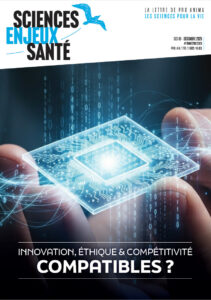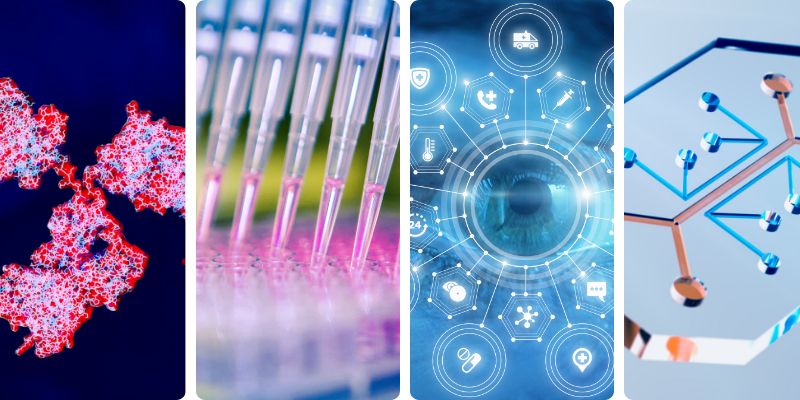
News on non-animal methods
Dec. 18 - 22, 2023
1. Professor Sue Gibbs receives lifetime achievement award for animal-free scientific research
Sue Gibbs , professor of Regenerative Medicine, received the Willy van Heumen Prize on December 12for her commitment to animal-free scientific research throughout her career. This prize is awarded every 10 years. Gibbs is nationally and internationally recognized as an innovator and advocate of animal-free scientific research.
In her more than 30-year career, Gibbs has been involved with great enthusiasm and in many ways in the successful development of animal-free therapies and testing strategies. She received, and continues to receive, national and international recognition for her important role as an innovator and advocate of animal-free scientific research , as evidenced by previous awards: Courage in the Lab, 2015 and Lush price, 2020 .
The Willy van Heumen Fund supports and encourages research into this with a biennial prize and a 10-annual oeuvre prize. During the event Ambition versus Realism Sue Gibbs received this prize in the form of a statuette, medal, certificate and an amount of € 15,000 that she can spend freely on research.
2. Design Criteria for Chemicals 2.0: Transforming EU chemicals regulation to better protect human health and the environment
According to estimates of theEuropean Environment Agency (EEA), approximately 70% of around 100,000 chemicals on the EU market have been poorly assessed for their safe use.
To address current challenges in assessing and managing chemical risks, the JRC proposes a new innovative concept of “Chemicals 2.0” for future safety assessment and management.
JRC scientists propose key criteria for Chemicals 2.0, including applicability to all substances, equivalent protection levels, maintaining current classifications, and using new approach methodologies for toxicodynamics and toxicokinetics. The scientists also suggest a new classification scheme into high, medium, and low concern levels, influencing risk management decisions.
3. EURL-ECVAM: Review of advanced non-animal models in biomedical research
EURL ECVAM has launched a series of studies to review available and emerging non-animal models being used for research in seven disease areas:
Encouraging the uptake of alternative methods is important to tackle such considerable reliance on animal experiments for carrying out research.
The aim is to identify and describe specific research contexts where animal models have been put aside in favour of novel non-animal techniques that use, for example, in vitro methods based on human cells and engineered tissues or in silico approaches employing computer modelling and simulation.
4 . NCad, Netherlands: Ambition statement on animal free innovations in Immunology
On 12 December, a new ambition statement was launched for the field of Immunology during a joint event of ZonMw and the NCad.
These ambition statements are written by experts in the field and meant to inspire researchers and other stakeholders to discuss future opportunities to reduce our dependence on animal testing and to speed up the transition to animal free biomedical science.The ambition statement contains recommendations pertaining to basal immunological research, education, regulations, and access/sharing to tissue and data.
5 . Skin barrier function for regulatory skin absorption tests and effects on testosterone and sucrose absorption
In vitro absorption through human skin is a critical component in the safety assessment of chemicals, crop protection products, consumer healthcare products and cosmetics.
A barrier integrity assay is used to identify skin samples which are potentially damaged. A retrospective analysis of 9978 electrical resistance (ER) measurements generated in a single laboratory (DTL) over a 15-year period was performed .
This retrospective analysis identified a new acceptance criterion, whilst not considerably changing results generated in skin absorption studies. Using this limit would, therefore, provide suitable skin samples for regulatory skin absorption studies.
6 . NHMRC has released two Statements to support the conduct of ethical, humane, responsible and high-quality research involving animals
The Statements support the implementation of the Australian code for the care and use of animals for scientific purposes (the Code), which is adopted into legislation in all states and territories.
The Statements highlight the significant scientific, welfare and ethical concerns associated with the forced swim test and smoke inhalation procedures in rodent models. They provide guidance on when the use of these procedures cannot be justified in accordance with the Code. They also outline actions that must be taken for a current NHMRC ‑funded project that involves the use of the forced swim test or smoke inhalation procedures in a rodent model.


